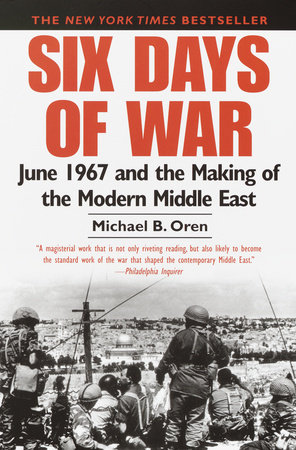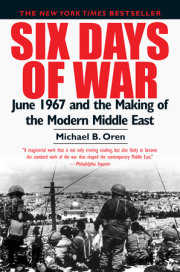AfterwoodMORE THAN TWO YEARS HAVE PASSED since the outbreak of the latest Middle Eastern turmoil, and there is still no cease-fire in sight. Called by Palestinians the al-Aqsa Intifada, and by the Israelis the “disturbances,” the “events,” or, simply, the Palestinian terror, the violence that erupted in September 2000, and which has raged ever since, is in every sense a war. No less than in 1948 and 1967, Arabs and Israelis are today once again battling over the final disposition of the area known in Arabic as
Filastin and in Hebrew as Eretz Yisrael—the Land of Israel. As in the processes leading up to previous Arab-Israeli confrontations, mounting violence between Palestinians and Israelis threatens to set the entire region ablaze.
In many respects, the current fighting resembles the civil war in Palestine
that broke out in November 1947, following the UN’s decision to partition the
country into independent Jewish and Arab states. The Zionist leadership accepted
the notion of territorial compromise, but the Arabs of Palestine saw no
reason to forfeit what they considered their exclusive national rights, and determined
to block the partition with attacks against Jewish settlements, road
systems, and neighborhoods. Other Arab forces, most prominently those associated
with the militant Muslim Brotherhood, aided the Palestinian Arabs from
across the border. The Jews, for their part, initially showed restraint, but in
April 1948, fearing annihilation, they too went to war. Subsequently, dozens of
Arab villages and towns were destroyed, their populations displaced, and their
leaders either killed or rendered ineffective. But the Palestinians’ defeat generated
sympathy throughout the Arab world and intensified the pressure on Arab
leaders to intervene against the Jews. The result came one month later with the
advent of the first Arab-Israeli war.
A remarkably similar process occurred more than fifty years later, in the
latter half of 2000, when the Clinton Administration again proposed to partition
the land between the Palestinians and the Jews. Specifically, the United
States called for the creation of a Palestinian state in virtually all of the West
Bank and the entire Gaza Strip—Israeli settlements would either be removed
or concentrated in blocks—with its capital in East Jerusalem. A small number
of Palestinian refugees would be repatriated to Israel; the rest were to receive
compensation. The Palestinian state would live side by side with Israel in relations
of full peace, but while Israeli prime minister Ehud Barak approved the
formula, the Palestinian Authority under its president, Yasser Arafat, rejected
it. Rather, Arafat demanded the return of all the refugees—a move that, if implemented,
would have created a Palestinian majority in Israel. As in 1947–48, the
issue was not merely the borders of the Jewish state, but its very existence.
The Palestinians consequently embarked on an armed offensive using tactics
reminiscent of those employed in 1947–48—roadside ambushes, snipers,
and car bombs—together with the innovation of suicide bombers. Militant Islamic
elements once more played a prominent role in the campaign. At first,
Israel’s reaction was again restrained, but as casualties rapidly mounted, the
IDF finally struck back. In April 2002, Israeli forces reoccupied much of the
West Bank, causing extensive damage to Palestinian cities and villages, and
killing or isolating many Palestinian leaders. As in 1948, the Palestinians’ plight
aroused sympathy in neighboring Arab countries and placed pressure on their
leaders to intercede. Soon Hezbollah guerrillas in Lebanon were launching
rockets into northern Israel; the Syrian army went on high alert, as did units in
Jordan, Egypt, and Iraq. Israel mobilized its reserves. The region careered toward
yet another Arab-Israeli war.
The fighting in 2000–2002 recalled not only the events of 1947–48 but,
even more poignantly, those of 1967. That war, this book asserts, was the result
of a series of incidents triggered by Palestinian guerrilla raids and Israel’s
retaliations against them. Today, more than three decades later, the Middle
East is still in the grips of a context of conflict in which a single spark can ignite
a regional conflagration. Such a spark was kindled in September 2000, when
Ariel Sharon, then head of Israel’s parliamentary opposition, paid a visit to the
Haram al-Sharif, or Temple Mount, in Jerusalem.
Though the visit had been cleared with the Palestinian Authority, many
Palestinians viewed it as a provocation and protested against it violently. Firing
on the rioters, Israeli forces provided the pretext for launching an
intifada, or
popular uprising, named after the Haram’s al-Aqsa mosque. Mass demonstrations
of Palestinian youths soon escalated into armed attacks against Israeli
targets, most of them civilian, and increasingly fierce countermeasures by Israel.
Israeli reprisals in turn instigated unrest in adjacent Arab countries. The
“street” was once again agitating—a déjà vu of 1967—and Arab rulers had little
choice but to act.
Unlike in 1948 and 1967, however, war between Arabs and Israelis did not
erupt in 2002. Though the region has remained in many ways unchanged, several
fundamental transformations nevertheless have combined to mitigate the
dangers of war.
There is, firstly, the existence of peace treaties between Israel and Egypt and
Israel and Jordan. In spite of their failure to bring about any true reconciliation
between their signatories, these agreements have nonetheless provided the nations
with open channels of communication and venues for reducing tensions.
Another change is the emergence of the U.S.-Israeli alliance that not only guarantees
Israel a decisive military edge over its enemies, but also affords Washington
far-reaching influence over Israeli actions. Finally, there is the nonconventional
weaponry now in the arsenals of virtually every Middle Eastern state, which has
sharply elevated the stakes in any Arab-Israeli confrontation.
Yet for every change curtailing the chances of war, another could equally
contribute to its outbreak. Absent today is the peculiar stability engendered by
the Cold War, of a rational counterpart whom the U.S. president might hotline
in a crisis, and superpower constraints over key regional players such as Iraq,
Iran, and Syria. The once neat division between Arab radicals and Arab conservatives
has been replaced by internal fissures within each Arab country—between
each regime and its domestic, often Islamic, opposition—and even the
lines in the Arab-Israeli conflict have become obscured. Most destabilizing,
arguably, is the growth of terrorist organizations, global in outlook and adamant
in their theology, transcending all borders and contemptuous of any attempt
to restrain them.
These countervailing changes, coupled with the continuing friction surrounding
nondemocratic Middle Eastern regimes and Arab resistance to the
very
idea of a Jewish state, might have set the stage for an Arab-Israeli war
bigger and possibly more destructive than those of 1948 and 1967. Instead, war
in 2002 was averted by the timely intervention of the United States. As tensions
in the region spiraled toward an explosion, President George W. Bush
strongly advised Syria to rein in its Hezbollah allies and told the Palestinian
Authority that its support of terror was totally unacceptable to Americans. At
the same time, Washington publicly recognized Israel’s right to defend itself
and convinced Israelis that they did not stand alone. Bush’s actions—admonishing
the Arabs and reassuring the Israelis—were precisely those that Lyndon
B. Johnson failed to take in 1967, and in 2002 they succeeded in containing, if
not defusing, the crisis.
Like Johnson, Bush was engaged in an international struggle with an implacable
enemy—no longer communism, of course, but Islamic extremism—
but rather than tie his hands as Vietnam once had Johnson’s, America’s new
conflict impelled George Bush to act. The events of September 11, 2001, spurred
a radical departure from long-standing American policies toward the Middle East.
Having become the victim of large-scale Arab terror, the administration voiced
newfound empathy for Israel and its struggle against suicide bombers and gunmen,
and went so far as to identify Israel’s enemies—Hamas and Islamic Jihad—
as America’s. Moreover, in declaring war against international terrorism, in
dispatching its soldiers thousands of miles to fight in Afghanistan and, avowedly,
in Iraq, Washington could hardly deny Israel the ability to strike back in
the West Bank and Gaza, its own backyard. Concomitantly, American leaders
expressed severe reservations regarding the Arab states, even toward their traditional
allies, Egypt and Saudi Arabia, citizens of which were heavily implicated
in 9/11. Relations between the U.S. and the Arab world were further
strained by the Arabs’ reluctance to support a military effort to invade Iraq and
oust its dictator, Saddam Hussein.
The success of Bush’s effort to rally an anti-Saddam coalition is not, as of
this writing, guaranteed. Numerous obstacles, domestic and foreign, stand in
the president’s way. Nor is it certain whether the toppling of Saddam will install
democracy or merely another dictatorship in Iraq, or whether war in the
gulf will ultimately enhance or further impair the area’s stability. One fact,
alone, is incontestable: that the Middle East remains a flash point of multilateral
confrontation, a source of seemingly intractable controversies, and a powder
keg that the slightest spark could ignite. A context of conflict continues to
seize the region, demanding of its leaders almost constant displays of both courage
and caution.
November 2002
Copyright © 2003 by Michael B. Oren. All rights reserved. No part of this excerpt may be reproduced or reprinted without permission in writing from the publisher.




